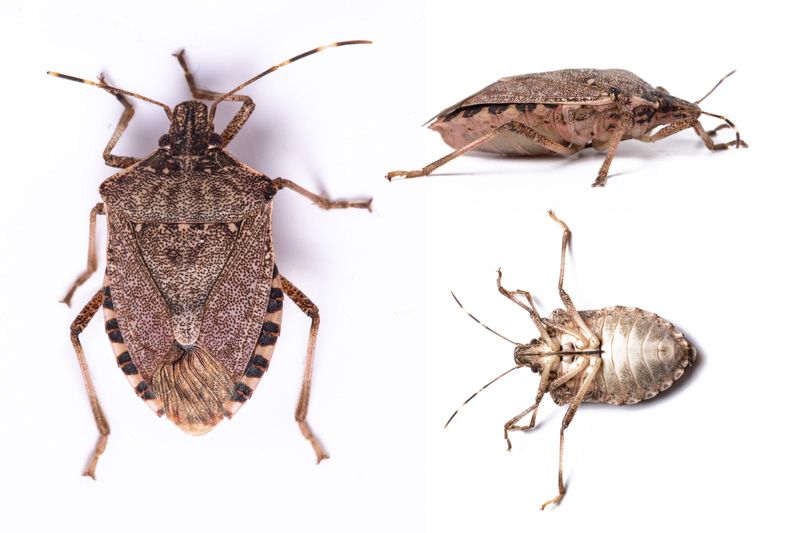
Brown Marmorated Stink Bug – Halyomorpha halys
Brown Marmorated Stink Bug – Halyomorpha halys
Description of Insect:
The brown marmorated stink bug (Halyomorpha halys) is an invasive insect species native to East Asia, including China, Japan, and Korea. Recognizable by its shield-shaped body, the stink bug measures approximately 12-17 mm in length. It is mottled brown on the dorsal surface, and beige on the ventral side, with alternating light and dark bands along the edges of its abdomen. The antennae and legs also show white bands, helping in the identification of the species. It is called “Marmorated,” which means “veined like marble” because of the streaking.
True to its name, the brown marmorated stink bug emits a pungent, unpleasant odor when disturbed. The odor-producing glands are located on the underside of the thorax between the first and second pair of legs. It lays eggs on the underside of the leaves giving rise to the nymph. The first instar nymphs are black with an orange-red abdomen, and grow up to 2.4 mm in length. The following nymph instars are darker with rough spiny projections and wing buds.
Adult stink bugs are notorious for their habit of invading homes and buildings during the fall, seeking shelter from the cold. Their ability to adapt to various environments has facilitated their rapid spread across North America, Europe, and beyond.
Life cycle of Brown Marmorated Stink Bug
The life cycle of the brown marmorated stink bug consists of three main stages: egg, nymph, and adult. Females lay barrel-shaped eggs in clusters of 28 on the undersides of leaves, typically during the warm summer months. These eggs are light green or light blue, and hatch within 4-5 days, releasing first-instar nymphs.
Nymphs go through five developmental stages (instars), progressively growing larger and changing in appearance. Early instars are black and red, while later instars develop a mottled brown pattern similar to adults. Each nymphal stage lasts approximately 1 week, with the fifth instar taking almost 2 weeks.
Adult stink bugs emerge from the final molt and begin reproducing within a few weeks. The entire developmental life cycle from egg to adult takes anywhere from 1.5 to 2 months. In warmer climates, there may be up to five generations per year, while cooler regions typically see just one or two. Adults can live for almost a year and overwinter in sheltered locations, emerging in spring to lay eggs.
Damage they cause:
The brown marmorated stink bug is a highly destructive pest with significant impacts on agriculture, ecosystems, and human environments.
- Agricultural Impact: The stink bug feeds by piercing plant tissues with its needle-like mouthparts and sucking out sap. This feeding behavior causes direct damage, such as necrotic areas on fruits, leaf stippling, discoloration, deformities, and premature fruit drop. It affects a wide variety of crops, including apples, peaches, pears, corn, soybeans, and raspberries. Entire fields or orchards can suffer economic losses due to the widespread feeding damage caused by stink bugs, making the crop unsellable. The mid-Atlantic tree fruit producers reported a loss of over $37 million in 2010, highlighting the economic impact of these bugs.
- Ecological Impact: The brown marmorated stink bug is highly polyphagous, meaning it feeds on a diverse array of plant species. This adaptability allows it to thrive in many environments, but it also places stress on native ecosystems. By competing with native insects and damaging host plants, the stink bug disrupts ecological balances and reduces biodiversity.
- Nuisance in Homes: In addition to their impact on agriculture and ecosystems, brown marmorated stink bugs are a major nuisance for homeowners. During the fall, large numbers of adult bugs seek shelter in homes, office buildings, and other structures to overwinter. They can enter through small cracks and crevices, clustering in attics, basements, and wall voids. While they do not bite or cause structural damage, their odor and sheer numbers make them unwelcome intruders.
